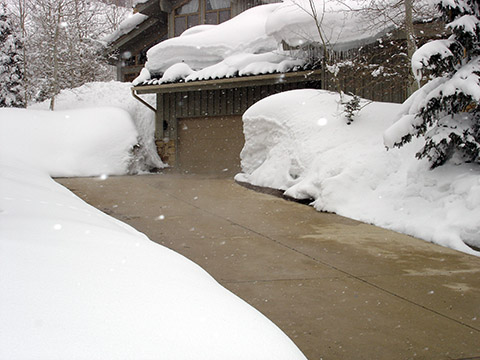
In addition to Warmzone's other customer support services, we provide you with free installation training. Installers can complete the course online via video conference, or in person at our headquarters. Call to sign up today at 888.488.9276.
Heated driveway systems utilize radiant heat to warm driveways and other outdoor areas to keep them free of snow and ice. Radiant heat is the most efficient technology available because there is virtually no heat loss, making driveway heating systems the most effective way to melt snow and ice from driveways, sidewalks, steps, and other areas.
Two technologies are available for heating driveways: electric and hydronic. Electric driveway heating systems utilize heat resistance cables that are laid out under the driveway’s surface. Hydronic systems feature a network of PEX tubing that is also embedded under the surface of the driveway. Both technologies can be installed in concrete, asphalt, or under pavers to efficiently heat the surface. Both systems are fully automated. Each utilizes an activation device (snow sensor) that detects weather conditions and activates the system when conditions warrant. The automated driveway heating system heats the area to prevent snow and ice from accumulating whenever a storm hits. Warmth radiates from the heating element to quickly and efficiently heat the driveway and prevent snow buildup. Electric driveway heating systems are especially easy to customize to meet the specific demands of the customer. Each Warmzone snowmelt system is custom designed to best meet the unique needs of the project in the most efficient and cost-effective way possible.
Heated driveways are easy to customize, so they can be tailored to meet the specific needs of each home or business owner. Systems can be custom designed to accommodate various budgets and available power, as well as unusual driveway layouts and regional weather conditions.

Both electric and hydronic heated driveways utilize three basic components: a heating element, a snow sensor / controller (also known as the activation device), and a UL listed contactor panel. Warmzone offers panels with or without GFEP included. (This is an excellent time and cost savings option for electricians.) The snow sensor / activation device is the unit that triggers these systems, so they activate only when needed, resulting in fully automated, worry-free performance.
Both ‘in-ground’ sensors (mounted in the pavement) and ‘aerial-mount’ sensors are available. Aerial sensors are most commonly used for residential heated driveway systems, and are typically mounted at the roofline of a home. It is placed in the open, away from trees, dormers or the roofline to allow falling snow unobstructed access to the sensor. When this device detects precipitation and a temperature below the designated (set) point, it signals the contactor panel, which is usually mounted in the garage. The contactor panel then sends power to the resistance heating cable and warmth immediately begins to spread across the driveway or sidewalk to prevent any snow buildup. As the storm ends and snow is no longer detected, the sensor enters its “afterrun” function. This allows the system to continue to run for a few more minutes in order to dry the driveway to prevent ice from forming. (For additional information about how heated driveway components work, visit our How Heated Driveways Work webpage.)
This same automation technology activates hydronic radiant heat systems as well, only the method for heating the driveway is different. Hydronic radiant heat systems utilize specially treated liquid (a mix of water and propylene glycol) that is heated by a boiler. A series of pumps then circulates the warm liquid through a closed loop of PEX tubing embedded in the driveway. Hydronic systems are much more complex and require a mechanical room for the pumps, boilers and manifolds; however, hydronic systems are also effective for keeping driveways clear of snow and ice – as well as heating floors. Hydronic systems can use whatever fuel source is available in the area, including: propane, natural gas, fuel oil, or wood, so homeowners can choose the least expensive option. This can result in a hydronic heating system having a slightly lower operating cost than an equally sized electric snow melting system. This can be especially advantageous if you are heating a large driveway or parking area.
Both electric and hydronic heated driveways boast a variety of benefits and advantages, so make sure you contact a trusted radiant heat expert to discuss your project and learn more about the various options available. Some smaller companies are biased because of their limited inventory and may try to convince you that the products from their restricted offering are ideal for you, so be sure to shop around. Deal with a provider that not only offers a selection of proven products, but offers both electric and hydronic solutions so you are not boondoggled into purchasing the only system that a salesperson is offering. (Remember, there is no single “one size fits all” solution for heated driveways. Each project should be carefully evaluated to determine the best custom heating option.)
Warmzone is a trusted leader that takes pride in offering free consulting and unbiased recommendations. Your system will be carefully analyzed before any recommendations are made. And after purchasing the system, you’ll receive the best service in the industry – service that includes free installation training, real-time technical support and industry-leading system design and layout services. Our products are proven industry leaders, and our customer service is second to none. Call us today to learn more at 888.488.9276.
Warmzone offers the proven ClearZone heat cable that is available for concrete and paver installations as well as cable with a specially designed outer jacket for installation in hot asphalt applications. (Maximum external jacket asphalt temperature specifications for this cable are: 220°F (105°C) [460°F (240°C) for up to 10 minutes.] For more details, contact Warmzone at 888.488.9276. The heat cable has been installed for virtually every type of snow melting application imaginable, including heating commercial parking ramps, driveways, sidewalks, outdoor malls, loading docks, runaway truck ramps, public transportation stations, government facilities, and more.
Learn more about
how heated driveways work.
Radiant Heated DrivewaysClearZone heated driveways are fully automated and require no maintenance. Learn how heated driveways work. |
Driveway Heating OptionsHeated driveways can be easily customized for your specific needs and budget. Read more about the heated driveway options. |
Snow Melting System BenefitsRadiant heated driveways possess a wide range of beneficial features. Learn more about the benefits of heated driveways. |
Heated Driveway InstallationWarmzone heated driveways are not difficult to install. Visit our heated driveway installation tips page to learn more. |
Installing a heated driveway is a wise investment in your home that can boost the value of your property. Fortunately, radiant snow melting systems aren’t limited to new construction jobs. Existing driveways can also be retrofitted with radiant heat. Asphalt driveways are particularly easy to add radiant heat. Concrete driveways can also be retrofitted with radiant heat using by using saw cut technology. Each project varies, so call a radiant heat expert and discuss the options for heating your driveway or sidewalks. You may be surprised by the many driveway heating options that are available.
As an industry leader, Warmzone offers comprehensive services that are virtually unmatched. These services include:

In addition to offering industry leading products, Warmzone includes technical support services.

Warmzone also offers free radiant heat installation training. Call 801-948-7545 to sign up today.

Warmzone includes professional radiant heat system design and layout services.
